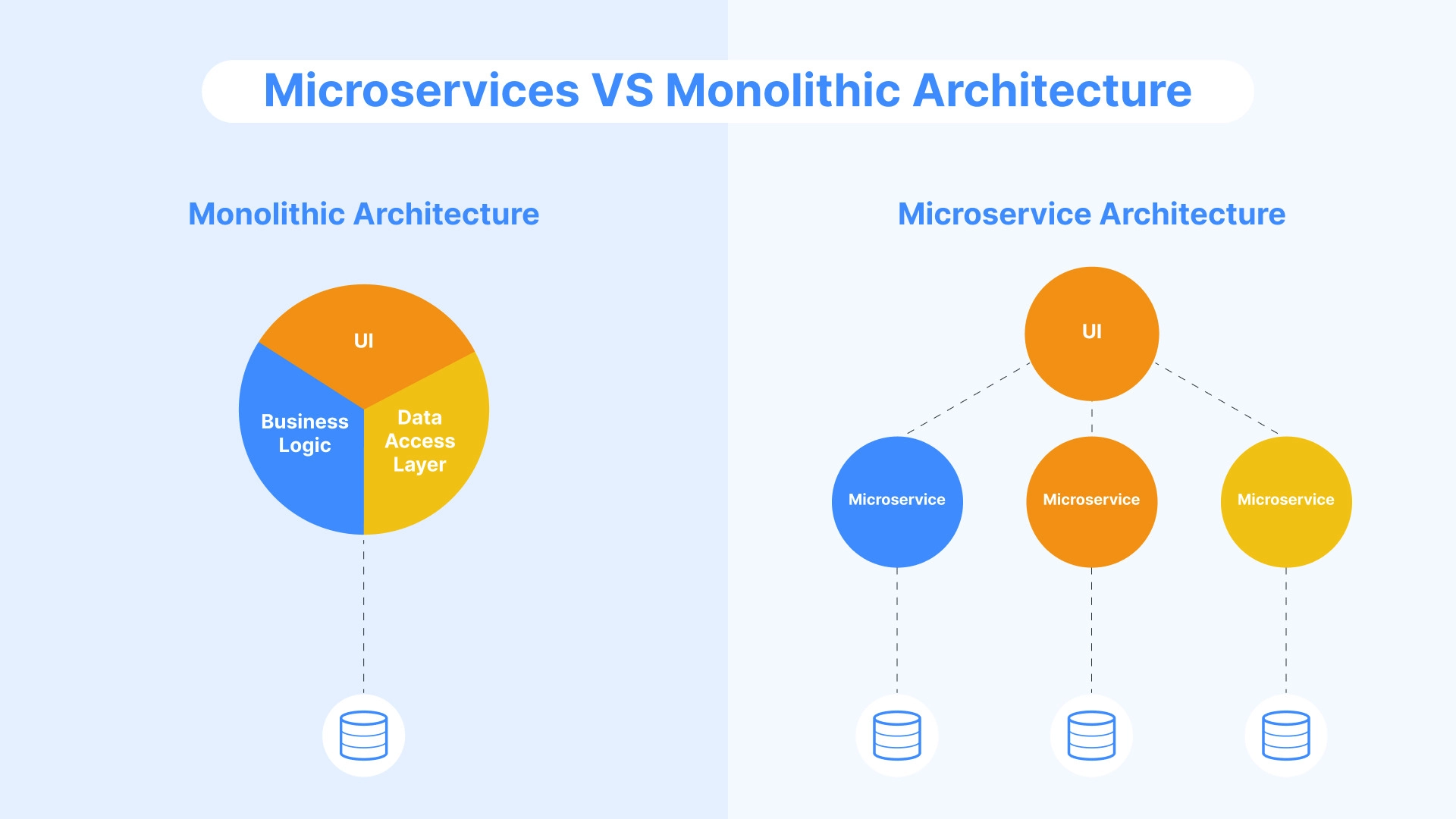

How Can the Microservices Architecture Benefit Healthcare?
Data volumes are increasing in all sectors, and healthcare is no exception with the adoption of wearables, electronic medical records, medical-grade sensors, etc. Data privacy and regulatory requirements in the sector drive additional demands around how this data is collected, stored, and managed, particularly around access to PHI.
The digital health industry is filled with considerations, complications, and regulations, but there is a way to manage these well-known issues — to implement a microservices architecture for healthcare.
There are many reasons why microservices are advantageous for healthcare. Before we jump into these motivations, let’s clarify the ecosystem that assembles the world of microservices.
What Are Microservices in General?
Microservices are more of a philosophy than just a development approach. So, what is it all about: applications are not developed step by step, but in such a way that different teams create all parts simultaneously. This is a special approach to the implementation of service-oriented architectures (SOA), which are used to create flexible software systems that can be deployed independently. The use of microservices significantly reduces the time to market, and also allows continuous modification of the system in a more scalable way.
Services in a microservices architecture are procedures that communicate over a network to reach their goals. They should be detailed and boiled down to primary business functions, while protocols should be lightweight (f.e., uploading photos or creating a user profile in the library, and more). Microservices architecture allows seamless deployment and delivery of complex applications, thus enabling organizations to improve their technology stack on the go.
Microservices VS Monolithic Architecture
A monolithic application represents a single-tiered software application. Its main feature is how the user interface and data access code are integrated into one program from one platform. Although it was very widespread, there are several reasons why you should make the evolution to microservices.

There are several downsides to using monolithic architecture. Among them are how its size is too big to allow for rapid and influential changes or a fast start-up time, while at the same time, it is more restricted in functionality than a microservice architecture would be.
Along with the issues regarding its size, developers have to redeploy the whole app on each update. Continuous deployment is difficult, and monolithic applications need help adopting new tech. Changes in frameworks or languages will affect the complete application, thus making it very expensive. All of the troubles that monolithic applications show can be nailed with the use of microservices.
Imagine, you have a chronic disease application for people with type 2 diabetes and you want to adapt that solution for managing patients with COPD. There is a significant amount of your foremost diabetes solution that you could reuse, but that would be challenging to do. Operating a chronic disease platform constructed as microservices, you could replace the element that interfaces and handles data from patients’ connected glucometers with one that follows readings from their pulse oximeters instead. The services that were shared with a partner application, or that captured additional insights from a virtual assistant, would all be reusable in each case. Implementing a microservices architecture for healthcare like this provides several advantages in architecting backend solutions while offering particular benefits in digital healthcare development.
Benefits of Microservices Architecture in Healthcare
Contemporizing healthcare app development and revving the go-to-market time does seem like an appealing way to go.
Microservices operate as a three-layer system: system APIs (core business powers), process APIs (components’ orchestration and choreography), and experience APIs (flexible functions and configurable options). As patient engagement, sustainability, and outcomes become more and more critical, the ability to micronize your healthcare environment will evolve the best healthcare practice. The quickness of delivery, accelerating innovation abilities, and new care models today are prerequisites for a functional and efficient business operation.
Here’s how the uptake of microservices can benefit the healthcare sector.
Compliance: As we all know, compliance is a priority in the development of healthcare solutions. Appropriate audits and inspections of your development must be satisfied. In large software architectures, it can be difficult to isolate the necessary components for your audits. Ultimately, this results in increased time spent proving your compliance. Microservices, in their turn, are combined as building blocks, and each individual service is naturally isolated from others in the system. This allows an isolated component to be tested without having to interfere with the rest of the development. This streamlines and hastens up your privacy tests.
Portability: Microservice solutions are portable and integrative in their nature. Each of the blocks can be used in future solutions or integrated into other systems, which creates an interoperable ground. Improved portability means healthcare professionals and patients can easily access the information they need. They can work in multiple systems using the same data.
Isolation: Downtime can be critical in any software development, and it is especially true for digital health. Depending on the application of the solution, access to critical data and patient care may be restricted. Poor error isolation and remediation can affect trust in a digital health solution. In a larger architecture, you need to comb through a lot of code to find the cause. And because each microservice is isolated, bugs can be caught quickly. The bug can be escalated to the appropriate team and work on updates and fixes can begin immediately.
High speed: Of course, starting a microservices architecture from scratch can take some time. However, they tend to evolve faster than monolithic architectures because teams don’t have to wait for each component to be built before moving on to the next one. Once created, new solutions can be quickly developed on top of existing microservices.
Flexibility: Microservices development is extremely flexible: it is important to stay abreast of the latest IT technologies and changes in healthcare. Since the demands and expectations of the public are changing, it is necessary to develop new solutions or quickly improve existing ones. Because each microservice component is independent, you don’t have to redesign the entire solution to meet demand. Modern applications include a variety of functionality. If we use the microservices architecture when developing, we can implement each of them with different technologies, that is, we can choose the best fit based on the task. This ensures faster performance, easier development, required resources, etc.
Some Words About the Downsides
Of course, the “dark side” of the issue isn’t the topic of our material. But you should keep in mind that the transition to microservices may have certain challenges. So consider whether the following moments are critical for you:
limited reuse of code;
operations configuration is more complex;
increased network traffic;
extra security requirements of the messaging scheme that connects the services.
Monitoring microservices can keep the extra complexity of apps, but it needs to be set and implemented with care and expertise.
Final Word
Microservices give your healthcare apps scalability, adaptability, and complexity that would not otherwise be obtainable. That’s why more and more businesses make a decision to opt for microservices. It really looks like an excellent option, especially for startups that are deeply interested in reducing costs and achieving better results.
Tell us about your project
Fill out the form or contact us

Tell us about your project
Thank you
Your submission is received and we will contact you soon
Follow us

